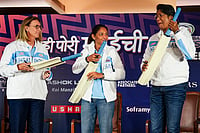A total of 176 tourists were on Tuesday airlifted from North Sikkim, which has been ravaged by a flash flood in the Teesta river, Chief Secretary VB Pathak said.
With this, a total of 690 tourists, including 26 foreigners, have been rescued by air from the Lachen and Lachung towns in North Sikkim by the Indian Air Force (IAF) since Monday, he said.
While seven IAF helicopters were deployed on Monday, four were deployed on Tuesday to bring the tourists to the Pakyong airport, he added.
Additionally, 499 people -- tourists and locals -- were shifted from North Sikkim to Mangan by other modes of transportation, from where they left for Gangtok in state-run buses and private taxis, Pathak said.
Nearly 1,200 people have been shifted from the North Sikkim district so far, he said.
The remaining tourists stranded in North Sikkim will be moved on Wednesday as the India Meteorological Department (IMD) has forecast clear weather, he said.
The IAF helicopters also transported nearly 58 tonnes of relief materials to North Sikkim for locals, and the Army and ITBP personnel posted there, the chief secretary said.
The telecommunication and power infrastructure has been restored in most areas of North Sikkim, one of the worst-affected districts, he said.
Almost a week after the flash flood, which happened in the early hours of October 4, 76 people are still missing. So far, 36 bodies have been found in Sikkim, while 41 bodies have been found at various places along the river in neighbouring West Bengal, according to officials in the two states.
A cloudburst in the Lhonak glacial lake led to the discharge of huge quantity of water, which triggered a flash flood in the Teesta river, flooding towns and villages and affecting about 87,300 people.


























